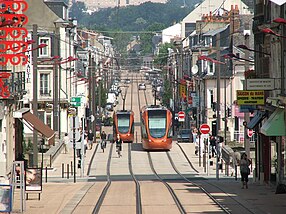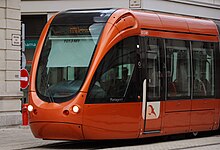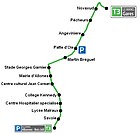Le Mans tram
| Le Mans tram | |
|---|---|
| Basic information | |
| Country | France |
| city | Le Mans |
| opening | November 17, 2007 |
| operator | SETRAM |
| Infrastructure | |
| Route length | 18.8 km |
| Gauge | 1435 mm ( standard gauge ) |
| Power system | 750 V DC overhead line |
| Stops | 35 |
| business | |
| Lines | 2 |
| Clock in the peak hours | Main route: 3 min |
| vehicles | 34 Alstom Citadis 302 |
| statistics | |
| Passengers | 48,000 per day |
| Network plan, valid since the end of August 2014 | |
Line 1 of the Le Mans tram ( French: Tramway du Mans ) was the cheapest of the new buildings in France in recent years for € 302 million. The first section, the Antarès - Université route, was released for use on November 17, 2007. The junction from the Saint-Martin stop to the eastern terminus Espal went into operation on December 22, 2007.
The tram service is operated by the Société des transports en commun de l'agglomération mancelle (SETRAM). It also organizes bus transport in the Le Mans metropolitan region, which, in addition to Le Mans, includes eight other municipalities.
The trams 1882–1947
overview
In Le Mans there were at times two complementary meter-gauge trams: from 1882 a system of steam-powered intercity trams and from 1897 - limited to the urban area of Le Mans - an electric tram called Tramway du Mans .
Both route networks were then referred to as Tramway (streetcar), although the steam trams had the character of a local or secondary railway .
Tramway de la Sarthe (1882-1947)
The surrounding area was connected to the city by a network of meter-gauge steam trams . The operator was the private company Compagnie des tramways de la Sarthe on behalf of the Department of Sarthe . The first lines were built in 1882, the last in 1922. In 1932 the first line closures, and in 1947 operations were completely stopped. After the completion of the expansion phase, the route network measured 416 km.
The routes of the urban electric tram and the overland trains were strictly separated from each other. The only crossing point was on the Pont en X bridge .
Tramway du Mans (1897-1947)
Routes and their history
Under the direction of the city of Le Mans, there were three electric lines in the city area. The network operator was the Compagnie de l'Ouest Électrique (COE).
Operations began on June 21, 1897: the approximately 3 km long line 1 was opened. Line 2 followed on June 27, also covering 3 km.
- Line 1: Train station - Avenue Thiers - Place de la République - Rue des Jacobins - Mallets
- Line 2: Croix d'Or - le Tunnel - rue Gougeard - Avenue de Paris
- Line 3: Hôpital - Pont Gambetta - Place Thiers - Place de la Mission - Lune de Pontlieue
Line 2 crossed under the historic old town in the "Tunnel des Jacobins" (today's name: rue Wilbur Wright ; still called "Le Tunnel" by the locals). It is an incision dug into a rock spur, approx. 200 m long, of which only 50 m in the central area are covered by a tunnel. Then she crossed the Sarthe on the “Pont en X” bridge. In 1914 the section Place des Jabobins ↔ Cimetière was abandoned due to low demand and instead the route was relocated along Avenue Thiers to the train station.
Each line was used by at least four cars per hour.
From 1912, further routes were planned, but could not be realized due to the outbreak of World War I.
vehicles
Initially there were 22 motor vehicles with an open platform at each end. For the warm season, twelve open sidecars could be used on Line 3. The latter were given the name "Buffalo" by the locals.
In 1931 six new cars from the Carel et Fouché company were purchased, but they did not correspond to the state of the art and z. B. did not have air brakes.
Pont en X
A special technical feature was the "Pont en X" (English: X-shaped bridge) created by Louis Harel de la Noë in 1898 . They were two bridges on iron girders that spanned the river Sarthe . They did not run perpendicular to the banks, but at an angle to them and crossed over the middle of the river. One bridge was used by the city's electric tram and the other by the Tramways de la Sarthe. On August 8, 1944, this construction was blown up by German soldiers to stop the advance of the Allies .
Pont en X, in the background the incision leading to the “Tunnel des Jacobins” , 1908
The end of the first tram network
The almost completely single-lane tram network came into trouble with outdated vehicles after around 40 years of operation in the mid-1930s and with increasing individual traffic.
As a first consequence, the tram service on the route to Pontlieue was stopped in 1936. Instead, Renault buses with wood gasifiers , which used charcoal as an energy supplier, were used.
In a further step, the tram was to be replaced by trolleybuses . In 1941 the first order for trolleybuses was placed with Vétra . In 1944 eight trolleybuses were delivered for use on the line to Pontlieue. In 1946, six more trolleybuses from the same manufacturer were added and were used on the routes to Les Maillets and Léon Bollée from November 1947.
The new tram
Initial plans for the reintroduction of the tram go back to 1992. In 1997 the route of the 15.4 km long line was determined. The Translohr system was considered as the vehicle, and in 2001 Alstom was ultimately commissioned to supply classic Citadis trams . In 2002, the cost of building the tram and vehicles was estimated at 290 million euros. The “Déclaration d'utilité publique” was signed in spring 2004. Work began in summer 2004 with the future route being cleared of supply lines. Work on the depot began in November. The first rails were laid in February 2006. The cost of building the route and purchasing the vehicles amounted to EUR 302 million.
The first test runs began in mid-July 2007. On July 20, a set traveled the entire route from south to north for the first time. The Antarès - Université route was the first to open on November 17, 2007. On December 22nd, 2007, traffic was also started on the eastern branch Saint Martin - Espal.
The average load on the tram is between 45,000 and 48,000 passengers per day.
The route network
The route network consists of two lines with a trunk line, which is used by both lines and on which there are seven stops.
Up until the opening of Line 2, the total length of the routes was 15.4 km. The network formed a three-pointed star with the Saint Martin station as a junction, with the two sections of the route south and east of Saint Martin (Saint Martin - Antarès and Saint Martin - Espal) being served alternately. There were a total of 30 stops, including the three terminal stops.
Despite efforts to keep construction costs low, 10 km of the network are laid out as grass track. During the construction - as is usual with new French trams - great importance was generally attached to a high-quality design of the route and stops, so that the tram fits seamlessly into the cityscape.
Line T1
Université - Saint Martin route
The western part of this consists of the longest and most important section, which covers the University of Maine Le Mans , the hospital, access to the historic old town and the city center with the pedestrian zone and the train station at the Gares stop . At the station there are transfer options to regional and long-distance trains as well as to several city and local bus routes. Between the stops Préfecture and Saint Martin runs which is also used by the trams of line 2.
Saint Martin - Antarès route
The route runs south from Saint Martin to the Antarès cultural center on the outskirts of the city, where the well-known motorsport circuit Circuit des 24 Heures and the MMArena football stadium, which opened in 2011, are located.
Line T2
The T2 line started operating in August 2014. The operator hopes to increase the capacity and attractiveness of the tram by up to 23,000 additional passengers per day.
Bellevue - Haut de Coulaines route
It is a 3.6 km long new line, with a total of six additional stops, which leads north from the Préfecture station. It was put into operation at the same time as line 2 was set up. It runs via the popular Place des Jacobins , near the Cathédrale Saint-Julien and ends near the city limits of Coulaines .
Saint Martin - Espal route
It opens up the Sablons district to the east of Saint Martin. At the terminus Espal is the Arche de la nature, a recreational and excursion area. This route was served by Line 1 until Line 2 opened.
Vehicle fleet
23 car sets were initially purchased for operation. On the occasion of the construction of Line 2, the fleet was increased to 34 vehicles. These are low-floor articulated railcars made by Alstom of the Citadis 302 type. The first multiple unit was delivered in January 2007, the last on November 7, 2007. Power is supplied via an overhead line that is operated with 750 V voltage.
The multiple units, which are equipped with air conditioning, are 32 m long and 2.40 m wide, they have 64 seats and can accommodate over 200 people. They could be extended by another 10 m by adding another module.
The trains all have a name. With the exception of the first delivered unit with the name "Désir", names were chosen that are in some way connected with the city of Le Mans or the surrounding communities.
Operating times
The trams run from 5 am to 1 am.
The time gap between two railways was initially only 5 minutes on the main Université - Saint Martin line and 10 minutes on the Saint Martin - Antarès and Saint Martin - Espal lines during rush hour. The distance between Université and Antarès was 34 minutes; for the connection Université - Espal a travel time of 31 minutes is forecast. According to the SETRAM timetable, however, before line 2 went into operation, 37.5 minutes for the Université - Antarès section and 34 minutes for the Université - Espal section.
When the T2 line went into operation in August 2014, the frequency was changed: a train now runs every 3 minutes on the main Préfecture - Saint-Martin line all day. On the outside routes (which are only served by one line each) the trains come every 6 minutes.
Line T3, but no tram
Line T3 goes from Le Mans station to the neighboring municipality of Allonnes . It was put into operation in February 2016. However, it is not a tram, but a Metrobus (BHNS = Bus à haut niveau de service), for which separate lanes have been created in sections. Around 40 million euros were spent on the 7.2 km long route and 14 stops. Driving time has been reduced from 33 minutes to 20 minutes thanks to the bus's own lanes and priority switches at intersections.
At the southern terminus and thus on the southwestern outskirts of Allonnes; as well as near the city limits of Le Mans / Allonnes there are P + R parking lots. The northern terminus, Gares, offers transfer options to the two tram lines T1 and T2, to the trains and to several city bus routes.
10 natural gas articulated buses of the type Crealis 18 from the manufacturer Iveco Bus are used .
literature
- Gérad Oudart: La Sarthe autrefois . Editions Horvarth, 1995, p. 24-35 .
Individual evidence
- ↑ a b c d Jean Tricoire: Le tramway en France . La Vie du Rail, Paris 2007, ISBN 978-2-915034-73-8 , p. 156-157 .
- ↑ a b [1] Homepage amtuir.org (French), accessed on August 2, 2018
- ↑ → Ref. Oudart p. 32
- ↑ Laurent Goulhen: L'album du Petit Train des Cotes du Nord . Association des Chemins de Fer des Côtes-du-Nord, Morlaix 2005, p. 36 f .
- ↑ Pont en X at structurae.info, accessed on January 8, 2018
- ↑ Si le pont en X n'avait pas sauté le 8 août 44 at ouest-france.fr, accessed on January 8, 2018
- ↑ Le Maine libre trial operation of line 2 from August 21, 2014 (French), accessed on November 20, 2014
- ↑ Decideurs en region (French) from September 4, 2014, accessed on November 21, 2014 ( Memento of the original from November 29, 2014 in the Internet Archive ) Info: The archive link was inserted automatically and has not yet been checked. Please check the original and archive link according to the instructions and then remove this notice.











